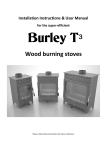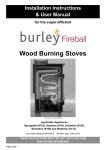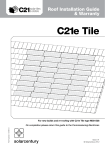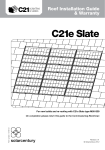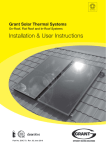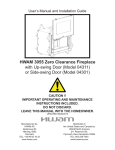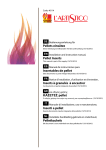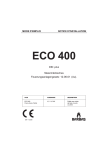Download Installation Instructions & User Manual
Transcript
Installation Instructions & User Manual Wood Pellet burning cooker Please retain these instructions for future reference. WARNING The ECO range cooker is wood pellet burning only, no attempt should be made to burn any other fuel, including all types of coal, grain or seed. Under no circumstances should liquid fuels be added. It is not an incinerator and rubbish including painted, tanalised wood and MDF should not be burnt in this appliance. Any attempt is dangerous and will invalidate any guarantees immediately. Technical data All built to EN13240 DEFRA approved Efficiency 82% CO concentration 0.1% @13% Oxygen Fuel Class A pellet 6-8mm diameter, see burner manual for details. Weight in kg 680 kg kW output intermittent 14kW Air vent requirement An air vent is required or direct connection to out side Minimum flue draught mm H²O 0.8mm Flue gas temperature Spigot Temp. Flue size Min. chimney diameter Max. chimney diameter Minimum distance to combustible materials Max. Hearth temp. Min. Hearth thickness 185 °C 241 °C 125 (5”) 125 (5”) 150mm (6”) 300cm behind (2ft). 20mm at side (3/4”) ** <100 °C 12mm ** Whilst you can reduce the side gaps right down because the LFH is the cool hopper and the RHS the oven, we recommend a 50mm/2” gap to cupboards. A removable front fill piece can then be used to close the gap. This allows good air circulation and help when moving the cooker for any major maintenance. Work tops can go up the cooker, but the top does get hot, so we recommend a 5mm minimum gap if granite is used and a 20mm gap if wood or Formica top are used. If non combustible materials surround the cooker, e.g., brick, block, ‘pink’ plaster board (standard plasterboard is back with cardboard and rated as flammable) then no gap is require behind or at the sides. Appliance Details Overall Size: Height (to hob) 910mm Width (standard models) 1500mm Depth (to towel rail) 720mm Flue 5” and 500mm from RHS of the cooker, centre line 120mm from the rear surface Hotplates: 3 Ovens: 340mm diameter x 2 with centre Height 280mm Depth 525mm Width 355mm Single electric induction hog, on LHS USER INSTRUCTIONS To light the cooker. Plug in or switch on the main power. Press the start button on the control panel. Turn the temperature dial to the desired temperature. Ensure the clock is in the ‘call for’ mode. General use: Adjust time clock if fitted to the desired times, (usually the same as you central heating). Leave the cooker on say 100C, the cooker will heat up to the temperature set and maintain that temperature whilst the clock calls for it. To cooker just turn up to you desired temperature say 180C and the burner will fire and take the oven up to that temperature. When you have finished cooker turn the oven back to previous setting say 100C. The cooler the outside temperature the more heat will be required in the kitchen, So in late spring early Autumn you might want to set the oven to just 50C, in early spring and late Autumn 100C and during those cold months Dec. Jan & Feb 150C. You can adjust the temperature on a daily basis. In the summer, most people leave the cooker at 0C and use the induction hob and onlt turn the oven on when required. Using your hotplates Your appliance has two hotplates, with a joint hotplate in the middle, protected with two insulated lids which should remain in a closed position when not using the hotplate. The lids can be raised independently if only using one hot plate. The hot plate temperature can be increased by turning up the oven temperature. The higher the temperature in the ovens, the hotter the hotplate will become. The design of the hot plates is such that the left hand side will become the hottest, making this suitable for deep fat frying, shallow frying and boiling. The surfaces of the hotplates are ground flat and it is therefore recommended that all utensils used have a solid, flat base to come in complete contact with the hot plate for efficient results. Using your Ovens Your appliance has 3 ovens. The thermometer dial in the top oven door provides an indication to the top oven temperatures. This thermometer reading will reduce quite dramatically when the door is opened and only recover slowly when the door is closed. This occurrence does not mean that the oven temperature has reduced. The bottom ovens are warmed by the underside of the oven above. Depending on the control device setting and operational time, this oven will generally operate some 85 – 90°C below the top ovens. It may be used for small food cooking, biscuits, cakes etc but it is best used as a warming compartment. Chimney sweeping & maintenance Your chimney should be swept at least once a year by a registered sweep, with a soft 5” round headed brush. The sweep should also: 1/ lift the oven clear out plates and vacuum those chamber out. 2/ Undo the screws holding the hot plate down and remove the hob with the handles provided. Vacuum out the top chamber and chimney debris space. The hob screws should be coated with ‘cooper slip’ before replacing. 3/ replace the fire cement at the base of the flue if necessary. 4/ Inspect all rope and glass seals and replaced as necessary. If the cooker has not been used for a prolonged period, in excess of 6 months, the chimney should be swept prior to use to check for blockages and rubble and debris blocking the flue ways. NOTE; All solid fuel appliances produce considerably more Carbon Monoxide in normal use than oil or gas appliances. But the general ‘smell’ of the smoke or exhaust is much stronger (with perhaps the exception of smokeless fuel) and more easily detected by a healthy person. Always use your appliance with the doors shut and look for tell tale signs of excessive leakage. Smoke stains above the fireplace, smoke emitting around the door when running, strong smell of soot upstairs etc. There is no such thing as a gas tight chimney, but there has to be a negative pressure inside a chimney for it to draw oxygen through the fire box. Check the seals at the joints annually and re-fire cement as required, check especially the joint of the flue pipe to the chimney register plate. Hairline cracks are OK, but lumps of cement missing are a bad joint. A proper proprietary joint should be used here, as they are far superior to cement and rope seals. Never block air vents internally and externally The surface of the appliance is hot in normal use; guards should be used when young children or infirm people are around. Never modify or fit parts not recommended by the manufacturer to the appliance. Never use this appliance in the same flue as another appliance. Installation Instructions When installing these appliances, all local regulations, including those referring to national & European Standards need to be complied with. This manual covers the ECO Range wood pellet cooker appliance. The nominal space heating output is: 4kW The above appliances must be installed by a HETAS registered installer and the installation registered with the local council. Failure to comply with the above renders all guarantees and liabilities of the manufacturer null and void. The manufacturer will not guarantee or accept liability for any problem that arises unless, a HETAS installation commissioning certificate has been completed and a valid receipt or proof of purchase is presented from the approved supplier. The appliances should not be fitted closer than shown in the chart, from combustible materials, e.g. a wooden fire surround or stud wall. When fitted against a wall made of combustible material e.g. a wooden stud wall with plasterboard, if the distance is less than the safe distance specified, extra non-combustible material of 75mm (min.) should be fitted behind the stove. When fitted inside a masonry or similar non-flammable material recess, e.g., fireplace opening, there is no minimum distance; the gaps are only an aesthetic consideration. Hearths The cooker should stand on a non-combustible heath of minimum thickness 12mm (1/2”). This should extend a minimum 225mm (9”) in front of the cooker. When the cooker is freestanding, the hearth should also extend a minimum of 150mm (6”) either side of the cooker. The hearth must be capable of taking the load of the appliance. Suitable measures, (e.g. a load distribution plate) should be taken if not, to ensure stability. The hearth should be flat and at the same height or slightly higher than the main floor. If tiles are added in front of the cooker afterwards, it is impossible to remove the cooker for any major maintenance. We recommend tiling the floor first before installation. Air supply All hydrocarbon burning appliances require an oxygen/air supply. If the chimney/cooker is to be fitted on an external wall the air supply can be taken straight from the outside. A 4” (100mm) diameter hole needs to be drilled in the correct place, 138mm above the hearth and the cooker ‘manifold/extension air pipe’ kit purchased and fitted. A proprietary grille is supplied with the kit, if not used an air brick or non-closing vent should be fitted to ensure the air supply is not blocked in any way. The manifold method of supplying air is always to be preferred as there will be no draught in the room especially when the cooker is not in use. If the cooker is not on an outside wall or the direct air supply method cannot be used, an air vent must be supplied in the room in which the cooker is fitted. The sizes of the vent required is: 1650mm sq. (50mm diam.) Only permanently open vents can be used and consideration should be given to draught when the cooker is not in use. Site these vents carefully. The vent covers should comply with Building Regulations Part J and should be sited where they cannot be blocked. Extractor Fans: These suck air out of the room and cause a negative pressure in the room so they must have their own air vent to counter this. Even when the air is taken directly from the outside using the manifold system a vent will be required for any extractor fan fitted in the same room or adjacent rooms. Great care must be taken with restaurant/café kitchens which have professional levels of extraction. Chimneys A chimney of minimum 5” diameter (125mm) and a minimum length of 4 metres is required, and it must comply with Building Regulations J. Never share the flue with another appliance. Without a chimney to these specifications there could be insufficient draw on the chimney to pull sufficient oxygen through the appliance to make it burn properly. If you live in a valley or are surrounded by tall trees or buildings you might experience downdraught problems where the wind tries to stop the fumes rising up the chimney. An anti-downdraught cowl might help, but anti-downdraught cowls reduce draw, so will not work on single storey chimneys and those with insufficient draw. We recommend you seek the advice of a HETAS or NACE registered supplier and installer before purchasing any cooker or heating appliance. We recommend any chimney larger than 200mm is lined using a Class I liner, and backfilled with insulation to Building Standard requirements. We recommend using the ECO Range register plate adaptor and adjustable vitreous enamel flue pipe which is designed for easy fitting. Smokeless Zone’s The ECO Range 3 oven pellet cooker is almost certainly the cleanest wood burning cooker in the world and so is DEFRA approved for burning wood in ‘smoke less’ zone in cities in the UK. Commissioning of the ECO Range wood pellet fired cooker appliance On completion of the installation, when any fire cement or paint used has dried, the cooker can be turned on Please leave the instructions with the customer and inform them;1/ when they first light the cooker, smoke will appear around the cooker and flue pipe with a strong acrid smell. This is normal and is the paint curing. If the cooker is fired properly for at least 2 hours this should not happen again. 2/ only top grade pellets should be used, preferable made from virgin soft wood. If hard wood pellets are to be use, a service technician with a gas analyser will be required to possibly adjust the air/fuel ratio. 3/ the hopper will require filling from between every 2 days to every month depending on the time of year/usage. Using the cooker as a room heater for long period will require more fuel, (but less of you other heating fuel). 4/ the ash will require emptying about every 10 fills of the hopper. The cooker should be allowed to cool down for 8 hour (overnight) and the majority of the ash removed using the vacuum cleaner attachment provided. Trouble shooting: In essence a wood pellet stove or cooker is a fairly simple , robust appliance, and they are not full of parts that fail easily & it is nearly always obvious if one of these parts has been broken or has failed. Baffles are made of stainless steel or ‘vermicuboard’: compressed, expanded volcanic rock, a bit like chip board. If these crack, again it is not a major problem and no harm will occur as long as they haven’t fallen out exposing the walls behind them. Of course they should be replaced if excessively cracked or broken, as soon as is possible and these parts all just slot into place. Spare can be ordered from the manufacturer or cut from a sheet of ‘Skamolex’ using a wood saw & the old broken baffle as a template. If installed correctly, running problems can only be caused by: a) Poor and/or wet fuel b) Poor chimney. Fuel should be the best Grade A pellets 6 or 8mm diameter. These can be bought in bags but must be kept in a dry storage area and they will absorb moisture and swell up and turn back to sawdust. Chimney problems divide into 2 clearly different sections: Draught. Down Draught & Lack of Lack of draught: A chimney is like a hot air balloon, the air inside want to rise up as it is hotter that the air outside. The 2 things that determine the performance of a hot air balloon are the size of the balloon, which equates to the height and diameter of your flue, and the temperature of the air inside, which equates to the quality of the chimney. If the pilot wants to go up, he turns the burner on and heats the air so it has more lift. If you have a large ‘cold’ chimney, as the smoke goes up it will cool and lose its buoyancy. This stops the rise and it is this rise or draw, that removes the products of combustion. The pellet burner has a fan built in to on initial lighting for about 2 minutes the cooker can be under positive pressure and a small amount of smoke can be forced back into the ovens if they are left open at this stage. This is safe and clears as soon as the chimney warms a few degrees above ambient and then has a negative pressure or draw. Signs of lack of draw: When, at all times, quantities of smoke come out joints and from the oven vents when the oven door is open. Solutions: Check that the flue is not blocked in the first place. Line the chimney, insulate the chimney/liner. No cowls will increase draw, they all reduce it. Down Draught: A roof is like the wing of an aircraft or the sail on a boat and causes pressure changes as the wind flows over and around it. To make matters worse, the surroundings also affect the flow and pressures. So if a chimney it not ‘tall’ enough it can end up in a high pressure zone, the air will then want to come down the chimney and out the back or front door, which can be at a lower pressure. Signs of a down draft: When quantities of smoke come out joints and from the oven vents when the oven door is open, on certain days only when the wind is blowing from a particular direction. (Usually from the opposite side of the roof that the chimney is Solutions: Raise the chimney, more twin wall or taller pot. Cut down surrounding trees. Fit a ‘Verdette’ or spinning type of cowl. The ECO Range Cooker is designed by Thornhill ECO Design Ltd, a designer company from Canterbury, UK, that specializes in efficient, clean & green cookers and stoves. ECO Range Cookers 60 Wincheap Canterbury Kent CT1 3RS www.ecorangecooker.co.uk












